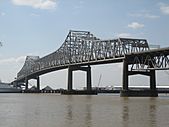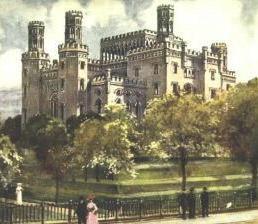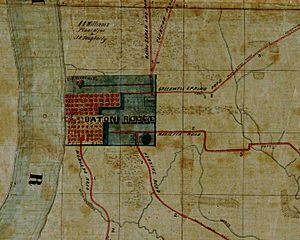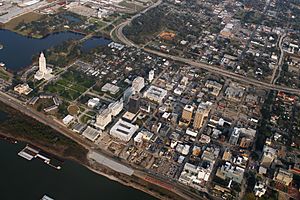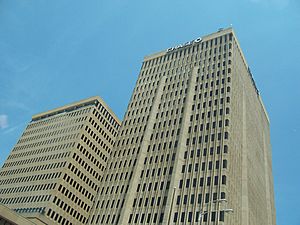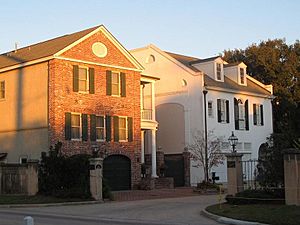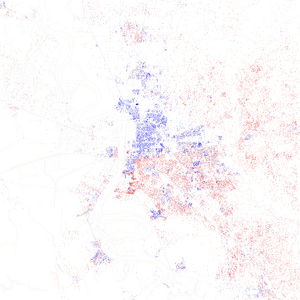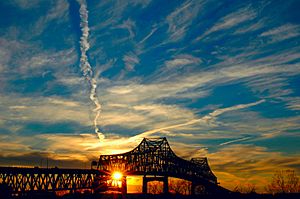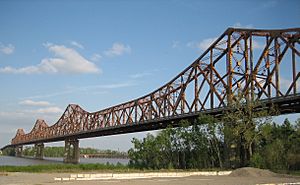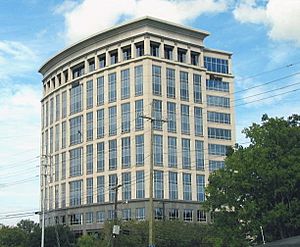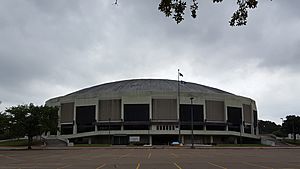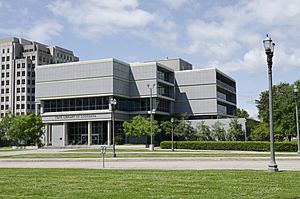Baton Rouge, Louisiana facts for kids
Quick facts for kids
Baton Rouge, Louisiana
Bâton-Rouge
|
|||||
|---|---|---|---|---|---|
|
State capital city and Consolidated city-parish
|
|||||
| City of Baton Rouge | |||||
|
From top, left to right: Downtown, Memorial Tower at LSU, USS Kidd, Louisiana State Capitol, St. Joseph Cathedral, Horace Wilkinson Bridge, Tiger Stadium (LSU), Old Louisiana State Capitol
|
|||||
|
|||||
| Nicknames:
Red Stick, The Capital City, B.R.
|
|||||
| Country | United States | ||||
| State | Louisiana | ||||
| Parish | East Baton Rouge | ||||
| Founded | 1699 | ||||
| Settled | 1721 | ||||
| Incorporated | January 16, 1817 | ||||
| Area | |||||
| • State capital city and Consolidated city-parish | 88.52 sq mi (229.27 km2) | ||||
| • Land | 86.32 sq mi (223.56 km2) | ||||
| • Water | 2.20 sq mi (5.71 km2) | ||||
| • Total | 79.11 sq mi (204.89 km2) | ||||
| Elevation | 56 ft (17 m) | ||||
| Population
(2020)
|
|||||
| • State capital city and Consolidated city-parish | 227,470 | ||||
| • Rank | US: 99th | ||||
| • Density | 2,635.32/sq mi (1,017.50/km2) | ||||
| • Urban | 594,309 (US: 68th) | ||||
| • Metro | 870,569 | ||||
| Demonym(s) | Baton Rougean | ||||
| Time zone | UTC−6 (CST) | ||||
| • Summer (DST) | UTC−5 (CDT) | ||||
| ZIP Codes |
70801–70817, 70819–70823, 70825–70827, 70831, 70833, 70835–70837, 70874, 70879, 70883, 70884, 70892–70896, 70898
|
||||
| Area code(s) | 225 | ||||
| FIPS code | 22-05000 | ||||
| GNIS feature ID | 1629914 | ||||
Baton Rouge ( BAT-ən-_-roozh; from French Bâton-Rouge, meaning 'red stick') is the capital of the U.S. state of Louisiana. On the eastern bank of the Mississippi River, it is the parish seat of East Baton Rouge Parish, the most-populous parish in Louisiana. Since 2020, it has been the 99th-most-populous city in the United States, and second-largest city in Louisiana after New Orleans. It is the 18th-most-populous state capital. At the U.S. Census Bureau's 2020 tabulation, it had a population of 227,470; its consolidated population was 456,781 in 2020. It is the center of the Greater Baton Rouge area, the second-largest metropolitan area in Louisiana, with a population of 870,569 as of 2020, up from 802,484 in 2010.
The Baton Rouge area owes its historical importance to its strategic site upon the Istrouma Bluff, the first natural bluff upriver from the Mississippi River Delta at the Gulf of Mexico. This allowed development of a business quarter safe from seasonal flooding. In addition, it built a levee system stretching from the bluff southward to protect the riverfront and low-lying agricultural areas. It is a culturally rich center, with settlement by immigrants from numerous European nations and African peoples brought to North America as slaves or indentured servants. It was ruled by seven different governments: French, British, and Spanish in the colonial era; the Republic of West Florida, as a United States territory and state, Confederate, and United States again since the end of the American Civil War.
Baton Rouge is a major industrial, petrochemical, medical, research, motion picture, and growing technology center of the American South. It is the location of Louisiana State University, the LSU System's flagship university and the largest institution of higher education in the state. It is also the location of Southern University, the flagship institution of the Southern University System, the only historically black college system in the United States. The Port of Greater Baton Rouge is the 10th-largest in the U.S. in terms of tonnage shipped, and is the farthest upstream Mississippi River port capable of handling Panamax ships. Major corporations participating in the economy of Baton Rouge and its metropolitan statistical area include Lamar Advertising Company, BBQGuys, Marucci Sports, Piccadilly Restaurants, Raising Cane's Chicken Fingers, ExxonMobil, and Dow Chemical Company.
Contents
History
Prehistory
Human habitation in the Baton Rouge area has been dated to 12000 – 6500 BC based on evidence found along the Mississippi, Comite, and Amite rivers. Earthwork mounds were built by hunter-gatherer societies in the Middle Archaic period, from roughly the 4th millennium BC. Proto-Muskogean divided into its daughter languages by about 1000 BC; a cultural boundary between either side of Mobile Bay and the Black Warrior River begins to appear between about 1200 BC and 500 BC, the Middle "Gulf Formational Stage". Eastern Muskogean began to diversify internally in the first half of the 1st millennium AD.
The early Muskogean nations were the bearers of the Mississippian culture, which formed around AD 800 and extended in a vast network across the Mississippi and Ohio valleys, with numerous chiefdoms in the Southeast as well. By the time the Spanish made their first forays inland from the shores of the Gulf of Mexico in the early 16th century, many political centers of the Mississippians were already in decline, or abandoned. At the time, the region appeared to be occupied by a collection of moderately-sized native chiefdoms interspersed with autonomous villages and tribal groups.
Colonial period
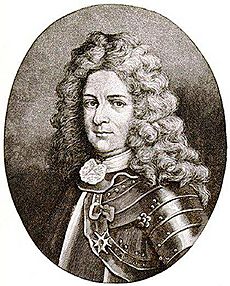
French explorer Sieur d'Iberville led an exploration party up the Mississippi River in 1699. The explorers saw a red pole marking the boundary between the Houma and Bayogoula tribal hunting grounds. The French name le bâton rouge ("the red stick") is the translation of a native term rendered as Istrouma, possibly a corruption of the Choctaw iti humma ("red pole"); André-Joseph Pénicaut, a carpenter traveling with d'Iberville, published the first full-length account of the expedition in 1723. According to Pénicaut,
From there [Manchacq] we went five leagues higher and found very high banks called écorts in that region, and in savage called Istrouma which means red stick [bâton rouge], as at this place there is a post painted red that the savages have sunk there to mark the land line between the two nations, namely: the land of the Bayagoulas which they were leaving and the land of another nation—thirty leagues upstream from the baton rouge—named the Oumas.
See also Red Sticks for the ceremonial use of red sticks among the Muscogee.
The location of the red pole was presumably at Scott's Bluff, on what is now the campus of Southern University. It was reportedly a 30-foot-high (9.1 m) painted pole adorned with fish bones.
The settlement of Baton Rouge by Europeans began in 1721 when a military post was established by French colonists. Since European settlement, Baton Rouge has been governed by France, Britain, Spain, Louisiana, the Republic of West Florida, the Confederate States, and the United States. In 1755, when French-speaking settlers of Acadia in Canada's Maritime provinces were driven into exile by British forces, many took up residence in rural Louisiana. Popularly known as Cajuns, the descendants of the Acadians maintained a separate culture. During the first half of the 19th century, the city grew steadily as the result of steamboat trade and transportation.
Modern history
Baton Rouge was incorporated in 1817. In 1822, the Pentagon Barracks complex of buildings was completed. The site has been used by the Spanish, French, British, Confederate States Army, and United States Army and was part of the short-lived Republic of West Florida. In 1951, ownership of the barracks was transferred to the State of Louisiana, and in 1976 it was placed on the National Register of Historic Places.
In 1846, the state legislature designated Baton Rouge Louisiana's new capital to replace "sinful" New Orleans. The architect James Dakin was hired to design the Capitol building in Baton Rouge, with construction beginning in late 1847. Rather than mimic the federal Capitol in Washington, as many other states had done, he designed a capitol in Neo-Gothic, complete with turrets and crenellations, and stained glass, which overlooks the Mississippi. It has been described as the "most distinguished example of Gothic Revival" architecture in the state and has been designated as a National Historic Landmark.
By the outbreak of the Civil War, the population of Baton Rouge was nearly 5,500. The war nearly halted economic progress, except for businesses associated with supplying the Union Army occupation of the city beginning in the spring of 1862. The Confederates at first consolidated their forces elsewhere, during which time the state government was moved to Opelousas and later Shreveport. In the summer of 1862, about 2,600 Confederate troops under generals John C. Breckinridge (the former Vice President of the United States) and Daniel Ruggles tried in vain to recapture Baton Rouge.
After the war, New Orleans served as the seat of the Reconstruction Era state government. When the Bourbon Democrats regained power in 1882, they returned the state government to Baton Rouge, where it has since remained. In his 1893 guidebook, Karl Baedeker described Baton Rouge as "the Capital of Louisiana, a quaint old place with 10,378 inhabitants, on a bluff above the Mississippi."
In the 1950s and 1960s, Baton Rouge experienced a boom in the petrochemical industry, causing the city to expand away from the original center.
A building boom that began in the 1990s continued into the 2000s, during which Baton Rouge was one of the fastest-growing cities in the South in terms of technology, and Metropolitan Baton Rouge was one of the fastest growing metropolitan areas in the U.S. (under 1 million), with 602,894 in 2000 and 802,484 people as of the 2010 census. Baton Rouge's population temporarily surged after Hurricane Katrina (2005), as it accepted as many as 200,000 displaced residents.
Geography and climate
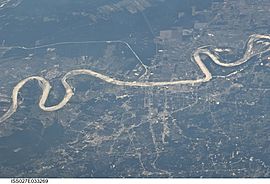
Baton Rouge is located on the banks of the Mississippi River in southeastern Louisiana. According to the United States Census Bureau, the city has a total area of 79.1 square miles (204.9 km2), of which 76.8 square miles (198.9 km2) is land and 2.2 square miles (5.7 km2) (2.81%) is water.
The city is located on the first set of bluffs north of the Mississippi River Delta's coastal plains. Because of its prominent location along the river and on the bluffs, which prevents flooding, the French built a fort in the city in 1719.
Baton Rouge is the third southmost capital city in the continental United States, after Austin, Texas, and Tallahassee, Florida.
Tallest buildings
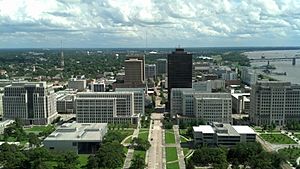
Baton Rouge's tallest buildings are:
| Name | Stories | Height |
|---|---|---|
| Louisiana State Capitol (Capitol Park; tallest state capitol building in the U.S.) | 34 | 450 ft (137 m) |
| One American Place | 24 | 310 ft (94 m) |
| JPMorgan Chase Tower (Chase) | 21 | 277 ft (84 m) |
| Riverside Tower North (Chase) | 20 | 229 ft (70 m) |
| Marriott Hotel Baton Rouge | 22 | 224 ft (68 m) |
| Mid-City Tower | 14 | 173 ft (53 m) |
Neighborhoods
Baton Rouge has many neighborhoods both inside and outside the city limits:
|
|
|
|
Climate
Baton Rouge has a humid subtropical climate (Köppen Cfa), with mild winters, hot and humid summers, moderate to heavy rainfall, and the possibility of damaging winds and tornadoes yearlong. The area's average precipitation is 55.55 inches (1,411 mm) of rain and 0.1 inches (0.25 cm) inches of snow annually. With ample precipitation, Baton Rouge is fifth on the list of wettest cities in the United States. Snow in the Baton Rouge area is usually rare, although it snowed in three consecutive years recently: on December 11, 2008, on December 4, 2009 and on February 12, 2010.
The yearly average temperature for Baton Rouge is 67.5 °F (19.7 °C) while the average temperature for January is 51.21 °F (10.67 °C) and August is 80.54 °F (26.97 °C). The area is usually free from extremes in temperature with some cold winter fronts but those are usually brief.
Baton Rouge's proximity to the Gulf of Mexico exposes the metropolitan region to hurricanes. On September 1, 2008, Hurricane Gustav struck the city and would become the worst hurricane ever to hit the Baton Rouge area. Winds topped 100 miles per hour (160 km/h), knocking down trees and powerlines and making roads impassable. The roofs of many buildings suffered tree damage, especially in the Highland Road, Garden District, and Goodwood areas. The city was shut down for five days and a curfew was put in effect. Rooftop shingles were ripped off, signs blown down, and minor structural damage occurred.
| Climate data for Baton Rouge, Louisiana (Metropolitan Airport), 1981–2010 normals | |||||||||||||
|---|---|---|---|---|---|---|---|---|---|---|---|---|---|
| Month | Jan | Feb | Mar | Apr | May | Jun | Jul | Aug | Sep | Oct | Nov | Dec | Year |
| Record high °F (°C) | 85 (29) |
88 (31) |
93 (34) |
96 (36) |
101 (38) |
103 (39) |
103 (39) |
110 (43) |
104 (40) |
98 (37) |
89 (32) |
88 (31) |
110 (43) |
| Average high °F (°C) | 62.3 (16.8) |
65.7 (18.7) |
72.7 (22.6) |
79.3 (26.3) |
86.2 (30.1) |
90.9 (32.7) |
92.2 (33.4) |
92.5 (33.6) |
88.7 (31.5) |
80.8 (27.1) |
71.9 (22.2) |
64.1 (17.8) |
78.9 (26.1) |
| Daily mean °F (°C) | 51.7 (10.9) |
55.1 (12.8) |
61.5 (16.4) |
68.1 (20.1) |
75.7 (24.3) |
81.1 (27.3) |
83.0 (28.3) |
82.9 (28.3) |
78.6 (25.9) |
69.3 (20.7) |
60.4 (15.8) |
53.4 (11.9) |
68.4 (20.2) |
| Average low °F (°C) | 41.2 (5.1) |
44.5 (6.9) |
50.3 (10.2) |
56.8 (13.8) |
65.2 (18.4) |
71.4 (21.9) |
73.7 (23.2) |
73.4 (23.0) |
68.5 (20.3) |
57.9 (14.4) |
48.9 (9.4) |
42.7 (5.9) |
57.9 (14.4) |
| Record low °F (°C) | 9 (−13) |
2 (−17) |
20 (−7) |
31 (−1) |
40 (4) |
53 (12) |
58 (14) |
58 (14) |
43 (6) |
30 (−1) |
21 (−6) |
8 (−13) |
2 (−17) |
| Average precipitation inches (mm) | 5.72 (145) |
5.04 (128) |
4.41 (112) |
4.46 (113) |
4.89 (124) |
6.41 (163) |
4.96 (126) |
5.82 (148) |
4.54 (115) |
4.70 (119) |
4.10 (104) |
5.60 (142) |
60.65 (1,539) |
| Average snowfall inches (cm) | 0 (0) |
0.2 (0.51) |
0 (0) |
0 (0) |
0 (0) |
0 (0) |
0 (0) |
0 (0) |
0 (0) |
0 (0) |
0 (0) |
0 (0) |
0.2 (0.51) |
| Average precipitation days (≥ 0.01 in) | 9.9 | 8.8 | 8.3 | 7.5 | 7.9 | 12.1 | 12.9 | 11.8 | 8.5 | 7.5 | 8.5 | 9.1 | 112.8 |
| Average relative humidity (%) | 62 | 75 | 73 | 73.5 | 74 | 75 | 76 | 78 | 77.5 | 75 | 72.7 | 73.5 | 76.5 |
| Source: NOAA The Weather Channel (record temperatures) | |||||||||||||
National protected areas
- Atchafalaya National Heritage Area
- Baton Rouge National Cemetery
- Independence Park Botanic Gardens
- Laurens Henry Cohn, Sr. Memorial Plant Arboretum
- LSU Hilltop Arboretum
- Magnolia Cemetery
- Port Hudson National Cemetery
Demographics
| Historical population | |||
|---|---|---|---|
| Census | Pop. | %± | |
| 1810 | 469 | — | |
| 1840 | 2,269 | — | |
| 1850 | 3,905 | 72.1% | |
| 1860 | 5,428 | 39.0% | |
| 1870 | 6,498 | 19.7% | |
| 1880 | 7,197 | 10.8% | |
| 1890 | 10,478 | 45.6% | |
| 1900 | 11,269 | 7.5% | |
| 1910 | 14,897 | 32.2% | |
| 1920 | 21,782 | 46.2% | |
| 1930 | 30,729 | 41.1% | |
| 1940 | 34,719 | 13.0% | |
| 1950 | 125,629 | 261.8% | |
| 1960 | 152,419 | 21.3% | |
| 1970 | 165,921 | 8.9% | |
| 1980 | 220,394 | 32.8% | |
| 1990 | 219,531 | −0.4% | |
| 2000 | 227,818 | 3.8% | |
| 2010 | 229,493 | 0.7% | |
| 2020 | 227,470 | −0.9% | |
| U.S. Decennial Census 2018 Estimate |
|||
| Race | Number | Percentage |
|---|---|---|
| White (non-Hispanic) | 77,829 | 34.22% |
| Black or African American (non-Hispanic) | 121,799 | 53.55% |
| Native American | 382 | 0.17% |
| Asian | 7,294 | 3.21% |
| Pacific Islander | 67 | 0.03% |
| Other/Mixed | 6,581 | 2.89% |
| Hispanic or Latino | 13,518 | 5.94% |
The U.S. Census Bureau determined Baton Rouge had a total population of 227,470 in 2020, down from 229,493 in 2010. The 2019 American Community Survey estimated 443,763 people lived in the consolidated area of Baton Rouge (East Baton Rouge Parish). The metropolitan population increased to 3.6% as a result of suburbanization in 2019, to an estimated 854,884. In 2020, the metropolitan population was 870,569. In 2019, there were 83,733 households with an average of 2.58 people per household. Baton Rouge had a population density of 2,982.5 people per square mile.
Per the 2019 census estimates, 21.6% of households had children under the age of 18 living in them. The owner-occupied housing rate of Baton Rouge was 49.8% and the median value of an owner-occupied housing unit was $174,000. The median monthly owner-costs with a mortgage were $1,330 and the cost without a mortgage was $382. Baton Rouge had a median gross rent of $879, making it one of the Southern U.S.'s most affordable major cities. In the city, the median household income was $44,470 and the per capita income was $28,491 at the 2019 census estimates. Roughly 24.8% of the city lived at or below the poverty line.
At the 2010 United States census, there were 88,973 households and 52,672 families. Of all households in 2010, 28.1% had children under the age of 18, 35.8% were married couples living together, 19.0% had a female householder with no husband present, and 40.8% were not families. About 31.7% of all households were made up of individuals, and 8.6% had someone living alone who was 65 years of age or older. The average household size was 2.42 and the average family size was 3.12. In the city, the population was distributed as 24.4% under the age of 18, 17.5% from 18 to 24, 27.2% from 25 to 44, 19.4% from 45 to 64, and 11.4% who were 65 years of age or older.
The median age in Baton Rouge in 2010 was 30 years. For every 100 females, there were 90.5 males. For every 100 females age 18 and over, there were 86.3 males. The median income for a household in the city was $30,368, and for a family was $40,266. Males had a median income of $34,893 versus $23,115 for females. The per capita income for the city was $18,512. About 18.0% of families and 24.0% of the population were below the poverty line, including 31.4% of those under age 18 and 13.8% of those ages 65 or over.
Race and ethnicity
At the 2010 United States census, the racial and ethnic makeup of Baton Rouge proper was 54.54% Black and African American, 39.37% White American, 0.5% American Indian and Alaska Native, 3.5% Asian, and 1.3% from two or more races. Hispanics or Latin Americans were 3.5% of the population. Non-Hispanic Whites were 37.8% of the population, down from 70.5% in 1970.
In 2019, the racial and ethnic makeup was 36.6% non-Hispanic white, 54.7% Black and African American, 0.3% American Indian and Alaska Native, 3.5% Asian American, 1.3% from two or more races, and 3.7% Hispanic or Latin American of any race. Of the population, roughly 5.5% were foreign-born from 2015 to 2019. The 2014 census estimates determined the Black and African American population was 56.1%, non-Hispanic whites 35.7%, American Indians and Alaska Natives 0.2%, Asians 2.8%, multiracial 1.1%, and Hispanics or Latin Americans 4.0%. Since the 2010 U.S. census, the non-Hispanic white and Black populations have fluctuated, while Black and African American residents remain the largest group in the area, similar to the trends in New Orleans.
Religion
Christianity is the predominant religion practiced in the Baton Rouge area. There is a large Catholic influence in the city and metro area (22.6%), owing in part to French and Spanish settlement, while Baptists are the second largest denomination (20.0%). The Catholic population are primarily served by the Latin Church's Roman Catholic Diocese of Baton Rouge. Prominent Baptist denominations include the National Baptist Convention (USA), National Baptist Convention of America, the Progressive National Baptist Convention, the American Baptist Churches USA, and Southern Baptist Convention.
Other large Christian bodies in the area include Methodists, Anglicans or Episcopalians, Pentecostals, Presbyterians, Latter-Day Saints, and Lutherans. Christians including Jehovah's Witnesses, the Metropolitan Community Church, Christian Unitarians, and the Eastern Orthodox among others collectively make up 14% of the study's other Christian demographic. Notable Methodist and Anglican/Episcopalian jurisdictions operating throughout the Greater Baton Rouge area include the United Methodist Church, African Methodist Episcopal Church, the Episcopal Diocese of Louisiana, and the Anglican Church in North America. Baton Rouge's Pentecostals mainly affiliate with the Assemblies of God USA and the Church of God in Christ, and Presbyterians are mainly members of the Presbyterian Church (USA).
The second-largest religion in Baton Rouge and its metropolitan area is Islam (0.4%). There are currently over six mosques in the Baton Rouge area, primarily affiliated with Sunni Islam. The Nation of Islam is also another prominent branch of the religion practiced. The Muslim demographic has grown out of Middle Eastern immigration and African American Muslim missionary work. The first Islamic private school in Baton Rouge was established in 2019. As of 2019, Orthodox Jews make up 0.2% of Baton Rouge's religious population, and 0.6% identify with eastern faiths including Buddhism and Hinduism. New religious movements including contemporary paganism have small communities in the area, and a minority affiliate with Haitian Vodou, Louisiana Voodoo, and Hoodoo. The remainder of Baton Rouge's population is spiritual but not religious, agnostic, or atheist.
Culture
Baton Rouge is the middle ground of South Louisiana cultures, having a mix of Cajun and Creole Catholics and Baptists of the Florida Parishes and South Mississippi. Baton Rouge is a college city with Baton Rouge Community College, Louisiana State University, Our Lady of the Lake College, and Southern University whose students make up some 20% of the city population. There is a sizable international population of about 11,300, the largest of which are people of Hispanic or Vietnamese descent. This contributes to Baton Rouge's unique culture and its diversity of heritage.
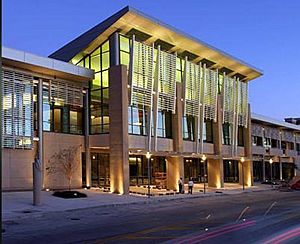
Arts and theater
Baton Rouge has an expanding visual arts scene, which is centered downtown. This increasing collection of venues includes the Shaw Center for the Arts. Opened in 2005, this award-winning facility houses the Brunner Gallery, LSU Museum of Art, the Manship Theatre, a contemporary art gallery, traveling exhibits, and several eateries. Another prominent facility is the Louisiana Art and Science Museum (LASM), which contains the Irene W. Pennington Planetarium, traveling art exhibits, space displays, and an ancient Egyptian section. Several smaller art galleries, including the Baton Rouge Gallery, offering a range of local art, are scattered throughout the city.
The city has several designated arts and cultural districts, the most prominent of which are the Mid-City Cultural District and the Perkins Road Arts District. These districts provide tax incentives, mostly in the form of exempting state tax on purchases, to promote cultural activity in these areas.
There is also an emerging performing arts scene. LSU's Swine Palace is the foremost theatre company in the city, largely made up of students of LSU's MFA acting program, as well as professional actors and stage managers. There is also a budding group of physical theatre and circus artists at LSU, who most recently traveled to Edinburgh, Scotland, in summer 2012 to perform Dante in the world's largest Fringe Festival. The show ran in Baton Rouge before going to Fringe, and featured movement, acrobatics, and aerial silk.
The Baton Rouge Little Theater offers a diverse selection of live theatre performances. Opera Louisiane is Baton Rouge's only professional opera company. The Baton Rouge Ballet Theatre is Baton Rouge's professional dance company. The Nutcracker – A Tale from the Bayou sets the familiar holiday classic in 19th-century Louisiana and has become a Baton Rouge holiday tradition. A Tale from the Bayou features professional dancers, a live orchestra and more than 300 area children.
Performing venues include the Baton Rouge River Center, Baton Rouge River Center Theatre for the Performing Arts, which seats approximately 1,900, the Manship Theatre, which is located in the Shaw Center for the Arts and seats 350, and the Reilly Theater, which is home to Swine Palace, a non-profit professional theater company associated with the Louisiana State University Department of Theatre.
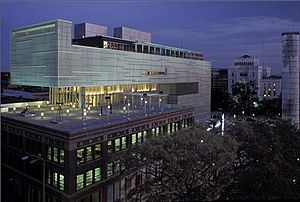
The Baton Rouge Symphony Orchestra has been in service since 1947 and currently performs at the River Center Music Hall downtown. Today, there are over 60 concerts annually performed by the Baton Rouge Symphony Orchestra directed by Timothy Muffitt and David Torns. The BRSO's educational component, the Louisiana Youth Orchestra, made its debut in 1984 and currently includes almost 180 musicians under the age of 20.
Events
Many events take place throughout the year. Every year Baton Rouge hosts many Mardi Gras parades, the largest one being held in historic Spanish Town. Other festivals include the biannual Restaurant Week, Greater Baton Rouge State Fair, FestforAll, Louisiana Earth Day, Mardi Gras season, the Wearin' of the Green St. Patrick's Day Parade, Bayou Country Superfest, and Red Stick International Animation Festival.
Miss USA pageants
In 2014, Baton Rouge was chosen to host the Miss USA Pageant. It took over downtown Baton Rouge as Nia Sanchez, Miss Nevada USA, took home the crown, with Miss Louisiana USA Brittany Guidry coming close to the win with the third runner-up spot and fourth overall. Veteran pageant host Giuliana Rancic and MSNBC news anchor Thomas Roberts introduced the 51 contestants before judges whittled them down to 20 semi-finalists to compete in the swimsuit, evening gown and interview competitions. Cosmo weighed in on the contest, complimenting home state girl Miss Louisiana. "
Baton Rouge hosted Miss USA again on July 12, 2015, won by actress and Miss Oklahoma USA Olivia Jordan.
Libraries
The State Library of Louisiana is in Baton Rouge. The Louisiana Legislature created the Louisiana Library Commission in 1920. This would later become the State Library of Louisiana. The State Library provides Louisiana residents with millions of items with its collections, electronic resources and the statewide network for lending. This allows the library to fulfill all requests from its citizens.
The East Baton Rouge Parish Library System has 14 local libraries with one main library and 13 community libraries. The main library at Goodwood houses genealogy and local history archives. The library system is an entity of the city-parish government. The system has been in operation since 1939. It is governed by the EBR Parish government and directed by the Library Board of Control. The Baton Rouge Metropolitan Council appoints the seven member board and then the board appoints a Director. According to its website, all branches are open seven days a week to assist the public with everything from reference and information to computer access.
The Louisiana State Archives' Main Research Library is located in Baton Rouge as well. It houses general history books, census indexes, immigration schedules, church records and family histories. The Library also has a computerized database of more than two million names that has various information about these people including census info, marriage info and social security filing info.
Louisiana State University and the Louisiana State University Law Center have libraries on their respective Baton Rouge Campuses.
Southern University and A&M College and the Southern University Law Center have libraries on their respective Baton Rouge Campuses.
Tourism and recreation
There are many architectural points of interest in Baton Rouge, ranging from antebellum to modern. The neo-gothic Old Louisiana State Capitol was built in the 1890s as the first state house in Baton Rouge and was later replaced by the 450 feet (137 m) tall, art-deco New Louisiana State Capitol which was the tallest building in the South when it was completed. Several plantation homes in the area such as Magnolia Mound Plantation House, Myrtles Plantation, and Nottoway Plantation showcase antebellum-era architecture. Louisiana State University has over 250 buildings in Italian Renaissance style, one of the nation's largest college stadiums, and is endowed with many live oaks. Several examples of modern and contemporary buildings are downtown, including the Capitol Park Museum. A number of structures, including the Baton Rouge River Center, Louisiana State Library, LSU Student Union, Louisiana Naval Museum, Bluebonnet Swamp Interpretive Center, Louisiana Arts and Sciences Center, Louisiana State Archive and Research Library, and the Pennington Biomedical Research Center, were designed by local architect John Desmond. The Pentagon Barracks Museum and Visitors Center is located within the barracks complex and the Yazoo and Mississippi Valley Railroad Company Depot, currently houses the Louisiana Art and Science Museum.

Museums around town offer a variety of genres. The Capitol Park Museum and the Old Louisiana State Capitol Museum display information on state history and have many interactive exhibits. The Shaw Center for the Arts showcases and the Louisiana Art and Science Museum showcase varied arts. LASM also includes science exhibits and a planetarium. Other museums include the LSU Museum of Natural Science and the USS Kidd.
Other attractions include the Mall at Cortana and the Mall of Louisiana (Louisiana's two largest malls) and Perkins Rowe, amusement parks of Dixie Landin'/ Blue Bayou, and dining at the Louisiana-cuisine restaurants.
Parks and recreation
Baton Rouge has an extensive park collection run through BREC (the Recreation & Park Commission for the Parish of East Baton Rouge). The largest park is City Park near LSU. The Baton Rouge Zoo is run through BREC and includes 1800+ species.
Transportation
Shipping
The Port of Baton Rouge is the 9th-largest in the United States in terms of tonnage shipped, and is the farthest upstream Mississippi River port capable of handling Panamax ships.
Highways and roads
Interstates
Baton Rouge has three interstate highways: I-10, I-12 (Republic of West Florida Parkway), and I-110 (Martin Luther King Jr. Expressway).
Interstate 10 enters the city from the Horace Wilkinson Bridge over the Mississippi River, curving at an interchange with Interstate 110 southeast, crossing the LSU lakes and Garden District before reaching an interchange with I-12 (referred to as the 10/12 split). It curves further southeast, towards New Orleans as it crosses Essen Lane near the Medical District. It passes Bluebonnet Blvd and the Mall of Louisiana at exit 162, and leaves Baton Rouge after interchanges with Siegen Lane and Highland Road.
Interstate 12 (The Republic of West Florida Parkway) begins in the city at the I-10/I-12 split east of College Drive, and goes east from there, crossing Essen Lane, Airline Hwy, Sherwood Forest Blvd, Millerville Road, and O'neal Lane before leaving the city when crossing the Amite River.
Interstate 110 (The Martin Luther King Jr. Expressway) stretches 8 miles in a north–south direction from the east end of the Horace Wilkinson Bridge to Scenic Highway in Scotlandville, Louisiana. It passes through downtown, North Baton Rouge, and Baton Rouge Metro Airport before ending at Scenic Highway.
US highways and major roads
Baton Rouge has two US highways, along with their business counterparts: Airline Highway (US 61) and Florida Boulevard.
US 190 enters the city from the Huey P. Long Bridge, beginning a concurrency with US 61 after an interchange with Scenic Highway, near Scotlandville. Its name is Airline Highway from this interchange to the interchange with Florida Blvd. At this interchange, US 190 turns east to follow Florida Blvd through Northeast Baton Rouge, exiting the city at the Amite River.
US 61 enters Baton Rouge as Scenic Highway until it reaches Airline Highway (US 190). It becomes concurrent with US 190 until Florida Blvd, where it continues south, still called Airline Highway. It passes through Goodwood and Broadmoor before an interchange with I-12. It continues southeast past Bluebonnet Blvd/Coursey Blvd, Jefferson Hwy, and Sherwood Forest Blvd/Siegen Lane before exiting the city at Bayou Manchac.
US 61/190 Business runs west along Florida Boulevard (known as Florida Street from Downtown east to Mid City) from Airline Highway to River Road in downtown. The cosigned routes run from Florida St. north along River Road, passing the Louisiana State Capitol and Capitol Park Complex before intersecting with Choctaw Drive. North of this intersection River Road becomes Chippewa Street and curves to the East. US 61/190 Business leaves Chippewa Street at its intersection with Scenic Highway. The route follows Scenic Highway to Airline Highway, where it ends. North of Airline on Scenic and East of Scenic Highway on Airline is US 61. US 190 is East and West of Scenic on Airline Highway.
These are important surface streets with designated state highway numbers: Greenwell Springs Road (LA 37), Plank Road/22nd Street (LA 67), Burbank Drive/Highland Road (LA 42), Nicholson Drive (LA 30), Jefferson Highway/Government Street (LA 73), Scotlandville/Baker/Zachary Highway (LA 19), Essen Lane (LA 3064), Bluebonnet Blvd/Coursey Blvd (LA 1248), Siegen Lane (LA 3246), and Perkins Road/Acadian Thruway (LA 427).
Traffic issues and highway upgrades
According to the 2008 INRIX National Traffic Scorecard, which ranks the top 100 congested metropolitan areas in the U.S., Baton Rouge is the 33rd-most congested metro area in the country. However, at a population rank of 67 out of 100, it has the second-highest ratio of population rank to congestion rank, higher than even the Los Angeles-Long Beach-Santa Ana metropolitan area, indicating a remarkably high level of congestion for the comparatively low population. According to the Scorecard, Baton Rouge was the only area out of all 100 to show an increase in congestion from 2007 to 2008 (+ 6%). The city also tied for the highest jump in congestion rank over the same period (14 places).
Interstate 12 used to have a major bottleneck at O'Neal Lane. The interstate was three lanes wide in each direction to the O'Neal Lane exit, where the interstate abruptly became two lanes in each direction and crossed the narrow Amite River Bridge. This stretch of road, called "a deathtrap" by one lawmaker, had become notorious for traffic accidents, many with fatalities. In 2007, ten people died in traffic accidents within a three-month period on this section of road. Governor Bobby Jindal and the Baton Rouge legislative delegation, in 2009, were successful in allocating state and federal funding to widen I-12 from O'neal Lane to Range Avenue (Exit 10) in Denham Springs. The construction was completed in mid-2012 and has significantly improved the flow of traffic. In 2010, The American Reinvestment and Recovery Act provided committed federal funds to widen I-12 from the Range Avenue Exit to Walker, Louisiana. Noticing the significant improvement in commute times, Bobby Jindal further funded widening to Satsuma, Louisiana.
Interstate 10 West at Bluebonnet Road also ranked within the top 1000 bottlenecks for 2008, and I-10 East at Essen Lane and Nicholson Drive ranked not far out of the top 1000. A new exit to the Mall of Louisiana was created in 2006, and the interstate was widened between Bluebonnet Blvd and Siegen Lane. However, the stretch of I-10 from the I-10/I-12 split to Bluebonnet Blvd was not part of these improvements and remained heavily congested during peak hours. In response, a widening project totaling at least $87 million began in late 2008. Interstate 10 was widened to three lanes over a five-year period between the I-10/I-12 split and Highland Road. In 2010, the American Reinvestment and Recovery Act provided supplemental funding for this project to extend to the Highland Road exit in East Baton Rouge Parish. Commute times have since plummeted for this section of interstate.
Surface streets in Baton Rouge are prone to severe congestion. However, roads are beginning to handle the number of vehicles using them after years of stagnation in road upgrades. Baton Rouge Mayor Kip Holden has instituted an extensive upgrade of East Baton Rouge Parish roads known as the Green Light Plan, geared toward improving areas of congestion on the city's surface streets. With its first project completed in October 2008, it has seen numerous others reach completion as of 2015, with several more under construction and still others yet to break ground.
A circumferential loop freeway was proposed for the greater Baton Rouge metro area to help alleviate congestion on the existing through-town routes. The proposed loop would pass through the outlying parishes of Livingston (running alongside property owned and marketed as an industrial development by Al Coburn, a member of President Mike Grimmer's staff), Ascension, West Baton Rouge, and Iberville, as well as northern East Baton Rouge Parish. This proposal has been subject to much contention, particularly by residents living in the outer parishes through which the loop would pass. Other suggestions considered by the community are upgrading Airline Highway (US 61) to freeway standards in the region as well as establishing more links between East Baton Rouge Parish and its neighboring communities.
Commuting
The average one-way commute time in Baton Rouge is 26.5 minutes, slightly less than the US average of 27.1 minutes. Interstates 10, 110 and 12, which feed into the city, are highly traveled and connected by highways and four-lane roads that connect the downtown business area to surrounding parishes.
According to the 2016 American Community Survey, 81.9% of working Baton Rouge residents commuted by driving alone, 8.5% carpooled, 3% used public transportation, and 2.4% walked. About 1.2% used all other forms of transportation, including taxi, bicycle, and motorcycle. About 3.1% worked at home. The city of Baton Rouge has a higher than average percentage of households without a car. In 2015, 10.4 percent of Baton Rouge households lacked a car, and increased slightly to 11.4 percent in 2016. The national average is 8.7 percent in 2016. Baton Rouge averaged 1.55 cars per household in 2016, compared to a national average of 1.8.
Airport
Located 10 minutes north of downtown near Baker, the Baton Rouge Metropolitan Airport connects the area with the four major airline hubs serving the southern United States. Commercial carriers include American Eagle, United Airlines, ViaAir, and Delta Air Lines. Nonstop service is available to Atlanta, Dallas-Ft. Worth, Houston, Austin, Orlando Sanford and Charlotte.
Rail
Three major rail lines, Kansas City Southern, Union Pacific, and Canadian National provide railroad freight service to Baton Rouge. Since 2006, Baton Rouge and New Orleans leaders as well as the state government have been pushing to secure funding for a new high-speed rail passenger line between downtown Baton Rouge and downtown New Orleans, with several stops in between.
Buses and other mass transit
Capital Area Transit System (CATS) provides urban transportation throughout Baton Rouge, including service to Southern University, Baton Rouge Community College, and Louisiana State University. Many CATS buses are equipped with bike racks for commuters to easily combine biking with bus transit.
Greyhound Bus Lines, offering passenger and cargo service throughout the United States, has a downtown terminal on Florida Boulevard.
Sister cities
After a visit to the Republic of China (Taiwan), Mayor-President Kip Holden unveiled plans to pursue a sister city agreement with a second Taiwanese city, Taipei.
Economy
Baton Rouge enjoys a strong economy that has helped the city be ranked as one of the "Top 10 Places for Young Adults" in 2010 by portfolio.com and one of the top 20 cities in North America for economic strength by the Brookings Institution. In 2009, the city was ranked by CNN as the 9th-best place in the country to start a new business. Lamar Advertising Company has its headquarters in Baton Rouge. Other notable companies headquartered in the city include BBQGuys, Marucci Sports, Piccadilly Restaurants, and Raising Cane's Chicken Fingers.
Baton Rouge is the furthest inland port on the Mississippi River that can accommodate ocean-going tankers and cargo carriers. The ships transfer their cargo (grain, oil, cars, containers) at Baton Rouge onto rails and pipelines (to travel east–west) or barges (to travel north). Deep-draft vessels cannot pass the Old Huey Long Bridge because the clearance is insufficient. In addition, the river depth decreases significantly just to the north, near Port Hudson.

Baton Rouge's largest industry is petrochemical production and manufacturing. ExxonMobil's Baton Rouge Refinery complex is the fourth-largest oil refinery in the country; it is the world's 10th largest. Baton Rouge also has rail, highway, pipeline, and deep-water access. Dow Chemical Company has a large plant in Iberville Parish near Plaquemine, 17 miles (27 km) south of Baton Rouge. Shaw Construction, Turner, and Harmony all started with performing construction work at these plants.
In addition to being the state capital and parish seat, the city is the home of Louisiana State University, which employs over 5,000 academic staff. One of the largest single employers in Baton Rouge is the state government, which consolidated all branches of state government downtown at the Capitol Park complex.
The city has a substantial medical research and clinical presence. Research hospitals have included Our Lady of the Lake, Our Lady of the Lake Children's Hospital (affiliated with St. Jude Children's Research Hospital), Mary Bird Perkins Cancer Center, and Earl K. Long (closed 2013). Together with an emerging medical corridor at Essen Lane, Summa Avenue and Bluebonnet Boulevard, Baton Rouge is developing a medical district expected to be similar to the Texas Medical Center. LSU and Tulane University have both announced plans to construct satellite medical campuses in Baton Rouge to partner with Our Lady of the Lake Medical Center and Baton Rouge General Medical Center, respectively.
Southeastern Louisiana University and Franciscan Missionaries of Our Lady University both have nursing schools in the medical district off Essen Lane. Louisiana State University's Pennington Biomedical Research Center, which conducts clinical and biological research, also contributes to research-related employment in the area around the Baton Rouge medical district.
The film industry in Louisiana has increased dramatically since the beginning of the 21st century, aided by generous tax incentives adopted by the state in 2002. In September 2013, the Baton Rouge Film Commission reported that the industry had brought more than $90 million into the local economy in 2013. Baton Rouge's largest production facility is the Celtic Media Centre, opened in 2006 by a local group in collaboration with Raleigh Studios of Los Angeles. Raleigh dropped its involvement in 2014.
Sports
College sports play a major role in the culture of Baton Rouge. The LSU Tigers and the Southern University Jaguars are NCAA Division I athletic programs with the LSU Tigers football and Southern Jaguars football teams being the local college American football teams. College baseball, basketball, and gymnastics are also popular.
Much of the city's sport's attention is focused on the professional teams in Greater New Orleans. Baton Rouge has had multiple minor-league baseball teams (the Baton Rouge Red Sticks), soccer teams (Baton Rouge Bombers), indoor football teams, a basketball team, and a hockey team (Baton Rouge Kingfish). The Baton Rouge Rugby Football Club or Baton Rouge Redfish 7, which began playing in 1977, has won numerous conference championships. Currently, the team competes in the Deep South Rugby Football Union. It also has an Australian rules football team, the Baton Rouge Tigers, which began playing in 2004 and competes in the USAFL. In addition, Baton Rouge is home to Red Stick Roller Derby, a WFTDA Division 3 roller derby league. Baton Rouge is also home to the Baton Rouge Soccer Club in the Gulf Coast Premier League and the Baton Rouge Rougarou, a college summer league baseball team and member of the Texas Collegiate League.
Education
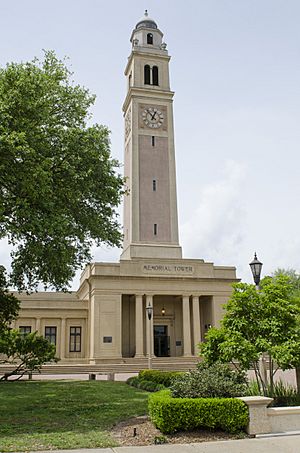
Baton Rouge is stimulated by many universities. Louisiana State University and Agricultural and Mechanical College, generally known as Louisiana State University or LSU, is a public, coeducational university that is the flagship campus of the Louisiana State University System. LSU is the largest university in Louisiana with over 30,000 students and 1,300 full-time faculty members. Southern University and A&M College, generally known as Southern University or SU, is the flagship institution of the Southern University System, the only historically black land-grant university system in the United States. SU is the largest HBCU and second-oldest public university in Louisiana.
Virginia College opened in October 2010 and offers students training in areas such as cosmetology, business, health, and medical billing. Franciscan Missionaries of Our Lady University is an independent Catholic institution also in the Baton Rouge medical district that has programs in nursing, health sciences, humanities, behavioral sciences, and arts and sciences. It has an associated hospital, Our Lady of the Lake Regional Medical Center. Tulane University is also opening a satellite medical school at Baton Rouge General's Mid City Campus in 2011.
Southeastern Louisiana University School of Nursing is located in the medical district on Essen Lane in Baton Rouge. Southeastern offers traditional baccalaureate and master's degree programs, as well as LPN and RN to BSN articulation. Baton Rouge Community College is an open-admission, two-year postsecondary public community college, established on June 28, 1995. The college settled into a permanent location in 1998. The college's current enrollment is more than 8,000 students. The Pennington Biomedical Research Center houses 48 laboratories and 19 core research facilities.
Primary and secondary schools
East Baton Rouge Parish Public Schools operates primary and secondary schools serving the city. The city of Baton Rouge is also home to 27 charter schools with a total enrollment of an estimated 11,000 students as of 2020. One of the latest includes the Mentorship Academy in downtown Baton Rouge, which leverages its location downtown to establish internship opportunities with local businesses as well as provide a high-tech classroom environment to focus on a digital animation curriculum.
The East Baton Rouge Parish School System is the second-largest public school system in the state and contains nine U.S. Blue Ribbon schools and a nationally renowned Magnet program. The school system serves more than 42,850 students and with the help of 6,250 teachers and faculty, the district has shown growth and increase in its District Performance Score. The East Baton Rouge Parish Public Schools serve East Baton Rouge Parish and has 90 schools with 56 elementary schools, 16 middle schools, and 18 high schools.
Libraries
The State Library of Louisiana is in Baton Rouge. The Louisiana Legislature created the Louisiana Library Commission in 1920. This later became the State Library of Louisiana. The State Library provides Louisiana residents with millions of items with its collections, electronic resources, and the statewide network for lending.
The East Baton Rouge Parish Library System has 14 local libraries with one main library and 13 community libraries. The main library at Goodwood houses genealogy and local history archives. The library system is an entity of the city-parish government. The system has been in operation since 1939. It is governed by the EBR Parish government and directed by the Library Board of Control. The Baton Rouge Metropolitan Council appoints the seven-member board and then the board appoints a director. According to its website, all branches are open seven days a week to assist the public with reference and information and computer access.
The Louisiana State Archives' Main Research Library is located in Baton Rouge, as well. It houses general history books, census indices, immigration schedules, church records, and family histories. The library also has a computerized database of more than two million names that has various information about these people including census, marriage, and social security filing information.
Louisiana State University and the Louisiana State University Law Center have libraries on their respective Baton Rouge campuses. Southern University and A&M College and the Southern University Law Center also have libraries on their respective Baton Rouge campuses.
Images for kids
-
USS Kidd, located downtown on the river, is part of the Louisiana Naval Museum.
-
Nottoway Plantation located near White Castle, 26 miles (42 km) south of Baton Rouge
See also
 In Spanish: Baton Rouge para niños
In Spanish: Baton Rouge para niños






